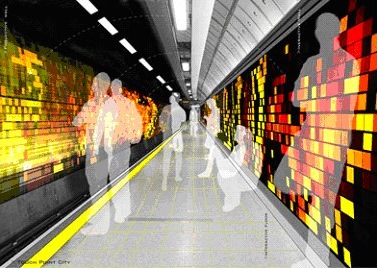
In relevance to the reading we read for last Thursday on Google, this video is pretty much a visual representation of the discussion-I thought it was very interesting!
Find it here.

Gilles Deleuze and Félix Guittari propose the idea of the rhizome in the "Introduction" from A Thousand Plateaus. The rhizome is related to the botanical idea of a plant that grows in multiple directions from a bulb as oppose to taking root from a seed. The authors posit that this structure can be related to the structure of thought (or lack thereof) in literature, though they seem to also suggest that the idea of a rhizome is a generalized structure that can be applied to a large number of other concepts (NMR 408-9). The authors break books down into three types of structures: the "root-book," the "radicle-system, or fascicular root," and the "rhizome" (408-9). The "root-book" refers to a book whose structure reflects that of a rooted tree, having a very well-defined structure (408). The "radicle-system" is defined to be more disjointed than the "root-book"; however, this model can still be considered to be a whole work (408). The rhizome is not supposed to reflect the world, and, "connects any point to any other point..." in the work (409). The authors are previously-published, stating at the beginning of the work that they published a previous work, Anti-Oedipus. As with the exact argument and the general writing style, the intended audience of the book is not made particularly clear. The introduction given in the New Media Reader suggests that the authors are very influential cultural writers.
The authors seemed to leave the actual definition of the "rhizome" very much open to interpretation, while setting some standards for what it is not. As the Introduction in the New Media Reader suggests, there definitions would likely be much clearer after reading the entirety of A Thousand Plateaus, or Anit-Oedipus (405). I have to disagree with the idea that such an unstructured style could exist and serve to transmit any useful or coherent information, though I also acknowledge that the authors never state a purpose for rhizomatic writing. The authors suggest that the movement through "Binary logic" in the "root-book" is limiting; however, I fail to see why another "root-book" could not expand on the first root-book in a different dimension to connect to a more complex analysis, as in the rhizome. The ability to use rhizomatic writing to describe hypertext escapes me, and I cannot think of a use or purpose; to me this article seems like the authors are being contrary purely for the purpose of being contrary. With that in mind, I propose the following discussion questions:
In her article, "Autistic Culture Online: Virtual Communication and Cultural Expression on the Spectrum," Joyce Davidson gives a call for awareness of the social movement of those on the Autistic Spectrum (AS). She cites evidence that the autistic community has a related 'form of life,' a "cultural grouping" of "... members who are 'related' in terms of the flexible notion of 'family resemblance'" (794). She then proceeds to discuss how those on the AS have difficulty communicating in 'neurotypical' (NT) social settings are finding the ability to form online communities centered around their AS 'form of life' (793-6). Davidson concludes by discussing different views on autism, including those who wish to 'cure' autism and those who would prefer to be identified as a minority group, and calls for an awareness of the latter.
Davidson appears to be appealing to those "neurotypical" people who are unaware of the movement for autism to be identified as a minority group. Though little is directly stated about Davidson in the article, it is shown to be published from the Department of Geography in Queen's University in a journal entitled Social & Cultural Geography. The title of the department would suggest that Davidson is a geographer, and not necessarily an expert in the subject of autism. Davidson does, however, have great respect for minority groups given her writing style; she uses the pronoun 'her' as a gender-neutral pronoun (793) and refers to the deaf community as "D/deaf," (798) possibly in consideration of those who do, and those who do not consider it a community. It is unclear if Davidson has anything to gain through the argument.
After reading the article, I felt embarrassed that I had only thought of people with autism as having a disorder, not as being associated with a larger community that was simply different. I would have to agree that with the author's argument that people on the AS should be treated as a minority community rather than as having a curable disorder. Davidson's wording became somewhat confusing in the discussion of a 'language game.' The description of autistic 'language games,' moving from Wittgenstein's definition of the link between, "a particular use of language with the 'actions into which it is woven'" to Davidson's definition of 'autistic language games' as something that, “might be seen as emerging from partially shared experiential background and 'identity'-that is, self-identification with a place on the spectrum" (794) seems like a very confusing way to identify a shared background among those on the AS; nonetheless, her argument stands. I would like to propose the following questions for discussion:



Myron Krueger, better known as “the father of virtual reality,” argues within his work Responsive Environments that the response is the medium. Thinking back to the beginning of man-machine interaction, the abilities of expansion were restricted, the ability of full throttle fun was restricted, and the overall concept was limited. Krueger states, “a responsive environment, is on which a computer perceives the actions of those who enter and responds intelligently through complex and auditory displays (379).” The creator, or the “artist” develops a cyber context relationship with the participant or player that builds and feeds off responses and change. Krueger mentions past projects such as GLOWFLOW, METAPLAY and PSYIC SPACE as having contributed to his ideas. For example, from GLOWFLOW he discovered that the experience could be heightened if the computer actively perceives as much as possible from the player. From METAPLAY he observed that both the viewer and the artist could respond to resulting images that in turn facilitated a unique real-time relationship between the artist and participant. PSYCHIC space implemented a musical means of expression with tones based upon the movement of their foot upon the tiles. VIDEOPLACE is the current project in progress. It is defined as “a conceptual environment with no physical existence. It unites people in separate locations in a common visual experience, allowing them to interact in unexpected ways through the video medium (384).” He argues that the video medium has the potential of being more rich and variable in some ways than reality itself. Which brings us to the idea of response is the medium. The medium must know as much as possible about what the participant is doing. The environment must be able to respond to the participants at all times. The final part of Krueger’s work argues that this idea of a responsive environment can have potentially real world application in the form of education, psychology, and therapy. He argues that in the realm of education, the responsive environment offers “a learning situation in which physical activity is encouraged. And may revolutionize what we teach as well as how we teach (388).” In terms of psychology we could use these types of environments as ways of monitoring. “Perceptions could be studied and data recorded without interfering with the interactions. And finally in the use of therapy the therapist can manipulate the subjects surrounding based on its simulation responses.
After trying to get through this idea of having a responsive environment and that being the message I find that yes, experimented virtual realities could progressively become real-life applications. Of the three areas mentioned I think the strongest would be in education. Thinking back to my learning experience versus say my mother’s, technology is much more widely accepted to where it is almost becoming expected. Now upon the arithmetic, English and basic subjects, computers and the Internet should be known and practiced skills. The idea of including a responsive environment in a learning setting could be beneficial in that it is more interactive and rather than a single head or teacher spewing facts for students to memorize, a virtual learning would allow students to be engaged physically and mentally and learn through cyber trial and error.
Unfortunately I was unable to attend the virtual reality lab so I do not have an experience to include but please feel free to share yours with me or compare each others!
Copyright © 2009 Media Bytes All rights reserved.
Designed by Paddsolutions. Converted To Blogger Template by Anshul.

Blog Archive